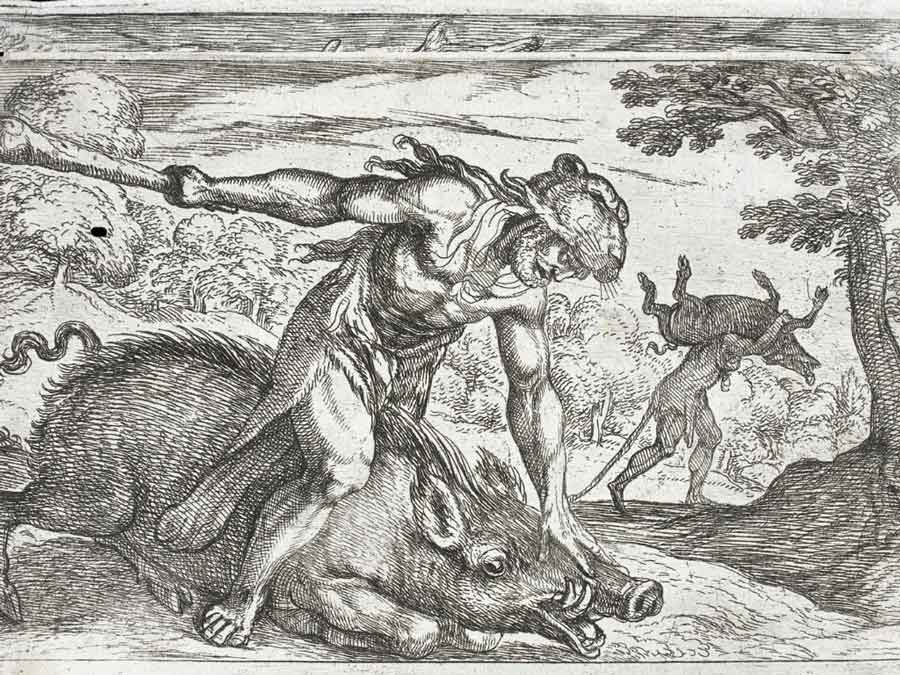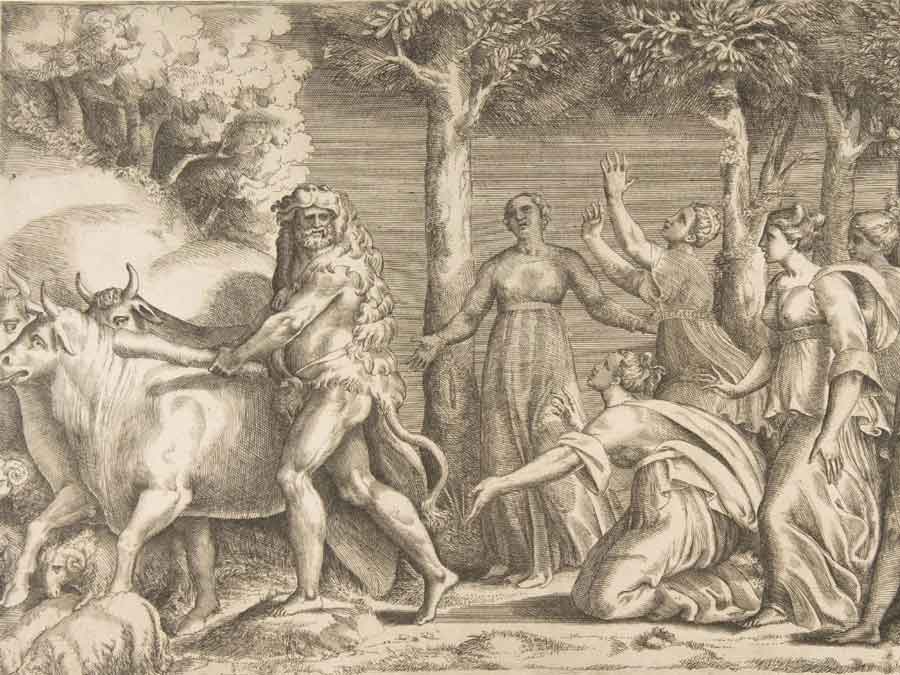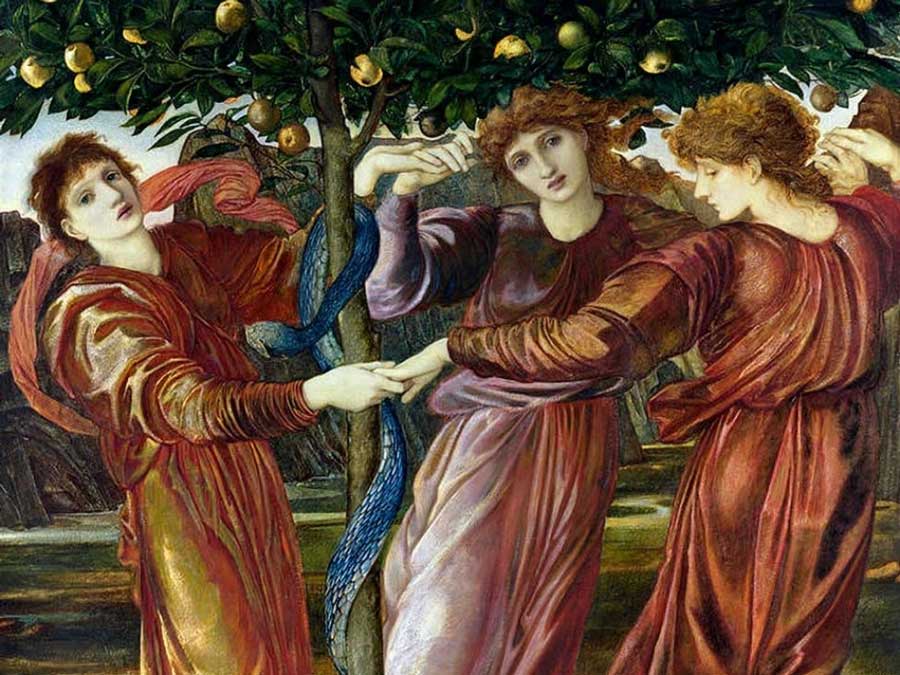Hercules, or Heracles in Greek, was Zeus’ son. Zeus, the King of the Olympian Gods, fell in love with a mortal woman named Alcmene and he was born out of their union. Hera, Zeus’ wife and Queen of Olympus, was extremely jealous. Shortly after the birth of Hercules, Hera sent venomous snakes to his crib to kill him. Although just a baby, Hercules showed the hero he would become, catching the snakes from their necks and killing them while laughing at the same time as it was just a game for him.
Hera set upon him many more traps, however, Hercules proved to be invisible. So, the goddess decided to be patient. After Hercules reached adulthood, he got married and lived happily with his family. That was the time when Hera decided to strike again. This time, she cast a spell on him and the Greek hero went entirely mad. During his frenzy, he killed his wife and children. When he snapped out of it and realized what he had done, he was inconsolable. The mythical hero tried everything in order to purify himself for the murder of his wife and children. For this purpose, Hercules traveled to the Oracle of Delphi and received an oracle, according to which, he had to serve for twelve years at Eurystheus’ court, the king of Tiryns. There, he would have to perform any labors that the king would command.
![Capitoline Museums [Public domain via Wikimedia Commons] Baby Hercules strangling a snake sent to kill him in his cradle](/images/Blog/Hercules/The-12-Labors-of-Hercules-killing-snakes.jpg)
Labor 1: Τhe Nemean Lion
In Greek mythology, the Nemean Lion was a lion that lived in the area of Nemea and spread fear. It was very dangerous, fast and with impenetrable skin. He was a descendant of Typhoon, Echidna and Chimera, all terrible ancient monsters in Greek mythology. This beast was eventually captured and killed by Hercules. From that day one, the Greek hero wore his lion fur on this head.

Labor 2: The Lernaean Hydra
The Lernaean Hydra is a mythical creature with nine heads, which Hercules killed in the second of his twelve labors. This monster was immortal. It lived in the area of Lerna - a swamp located south of Argos - from where it got its name. According to the legend, when Hercules cut off one head, two came out on its place. Only by burning it with fire did he manage to stop the multiplication. The last head, which was both the central head and immortal, was cut off and buried in the ground so that it would not come to life again. Hercules dipped his arrows into the monster’s venomous blood, a weapon that would prove very useful to him in his life.

Labor 3: The Hind of Keryneia
The hind of Keryneia was a mythical creature found in various legends of ancient Greece, most famously the ones related to the great Hercules. It is related to Artemis, the goddess of wildlife. According to the legend, when Artemis was still young, she saw five deer grazing in the Thessalian plain. Blurred by their beauty, she grabbed the four and put them in her chariot.
The fifth, however, who had golden horns and ran very fast, managed to escape. It headed south and after days, after crossing the Peloponnese, it was convinced that it had escaped and settled permanently on Mount Kyreneia. Then Artemis, admiring her free and unruly character, put the animal under her protection. King Eurestheus asked Hercules to capture the hind. It took the hero one whole year to capture the hind but, after showing great persistence, Hercules managed to complete this labor too.

Labor 4: The Erymanthian Boar
The Erymanthian Boar was a mythological being, killed by Hercules in his fourth labor. The goddess Artemis had gifted Erymanthos a huge wild boar. Eventually, it escaped and traveled around the Peloponnese, terrorizing and destroying the crops of the villagers, killing any other animal it would meet. The King ordered Hercules to catch the boar and bring it alive to Argos. After trying hard, the hero succeeded in catching the and bringing it to Eurystheus alive.

Labor 5: The Stables of Augeas
The Stables of Augeas were the huge stables of the king of Ilis, Augeas, with the 3,000 oxen, which had not been cleaned for a very long time - 30 years to be more precise! That was Hercules’ fifth labor. Cleaning these stables from the 30-year old dung seemed an impossible task. A task that Hercules had to complete in a day! At first, Augeas mocked the hero for trying but accepted the challenge and set his eldest son, Fyleas, as a witness. Hercules cleaned the manure by digging two ditches in the foundations of the stables and turning the flow of two rivers, Pinios and Alfeiosr, to pass through the stables! The waters of the two rivers carried away all the dung. Hercules once more finished his work within the predetermined deadline.
Labor 6: The Stymphalian Birds
The Stymphalian Birds were cannibalistic birds with copper beaks, claws and wings. They were posing a huge threat to people, herds and crops. Hercules did not know how to get them out of the dense vegetation of the lake they were occupying. The goddess of wisdom, Athena, well-known as a helper of heroes, came to his aid. She gave him copper rattles forged in Hephaestus' workshop, which the hero knocked from a hill by the lake. The birds flew away in terror and Hercules exterminated them with his poisonous arrows.
![Credit: Albrecht Dürer [Public domain via Wikimedia Commons] Hercules killing the Stymphalian Birds in his 6th labor](/images/Blog/Hercules/The-12-Labors-of-Hercules-the-Stymphalian-Birds.jpg)
Labor 7: The Cretan Bull
According to one version, the bull was born at the request of the king of Crete Minos. Specifically, Minos promised the god of the sea, Poseidon, that he would sacrifice in his honor everything that came out of the sea. Then the bull emerged from the sea, but Minos, ecstatic by the beauty of the animal, sacrificed another animal in its place hoping to deceive the god. Poseidon got angry and made the bull manic. The great bull began to cause huge damage to the land and the people. Hercules was sent to Crete to capture the beast and for once more he was victorious!
Labor 8: Diomedes’ Horses
Diomedes’ horses were four beings very unique in Greek mythology. The horses were owned by Diomedes, son of Ares and King of Thrace. He trained them to be cannibalistic and they had copper jaws (similar to the Stymphalian Birds). They were constantly tied with iron chains. Diomedes used to feed them with every unfortunate stranger who sank on the shore of his kingdom. Hercules was sent to capture them. He first defeated Diomedes and, to distract the beasts, he threw him as food to them. Then, he shut their mouths, tamed them and brought before the King Eurystheus.

Labor 9: The Belt of Hippolyte
Hippolyte was the queen of the great female warriors, the Amazons. Her belt had been given as a gift by the god of war, Ares. For the Amazons, this belt was an emblem of power. Reasonably, the daughter of King Eurystheus wanted to obtain this belt, so Eurystheus instructed Hercules to steal it from the Amazons and bring it to him. Hercules was accompanied on this mission by several of his companions. On their journey to the Black Sea, they faced many adventures, as expected. Finally, when they arrived at the Amazons’ island, Queen Hippolyte gave him the belt out of respect to a fellow soldier. Hera, who never stopped watching and cursing Hercules, was furious about this development and tricked Hippolyte who started a fight after all… So, Hercules had no other choice but to kill the queen of the Amazons and leave with the belt.
Labor 10: The Cattle of Geryon
Geryon was a giant with three heads and three sets of legs, joined at the waist. He was very powerful and had overcome all who had faced him. He was a grandson of the terrible monster Medusa and was guarding a herd of red cattle. The herd was also guarded by Eurytion, the herdsman, and Orthros, a monstrous dog, the son of Typhoon and Echidna. Orthros had two heads and seven snake-heads as tails! The mission of Hercules in this labor was to abduct the cattle. As soon as the hero arrived in Erythia, he came face to face with the two guardians. The hero managed to kill both with his bat. After Geryon heard about these events, he hurried back to face the invader. Hercules managed to exterminate the three-headed giant, after shooting him with his poisonous arrows.

Labor 11: The Apples of The Hesperides
The Apples of the Hesperides were, in Greek mythology, the golden fruits of the trees that were in the garden of the Hesperides. These golden apples were a wedding gift to Hera from the primordial goddess Gaia. Hera planted the trees in the garden of the gods, which was located in the land of Atlas. The Titan Atlas was outside the garden, carrying the heavens on his shoulders on all eternity, a punishment imposed on him by Zeus. When Hercules arrived there, Atlas tricked Hercules to carry the heavens in his place for a bit, so that he brings the golden apples to him.
He did bring the apples, however, he informed Hercules that he had to carry the world on his shoulders now and Atlas would take the apples to King Eurystheus. Hercules slyly agreed but asked the titan whether he could the burden back again, just for a moment, until the hero put some soft padding on his shoulders. Atlas left the apples on the ground and took over the weight of the heavens on his shoulders. Hercules picked up the apples and run off to the King’s court, leaving Atlas back.

Labor 12: Cerberus
Cerberus was the guardian of the Underworld and the pet dog of god Hades. He was a monstrous, three-headed dog and a tail that ended in a dragon's head. His presence ensures that the dead souls don’t escape the Underworld but also that the living people cannot cross the gate to the realm of the dead. The last labor of Hercules was to bring Cerberus to King Eurystheus. Hercules asked god Hades the permission to take Cerberus to Eurystheus so he could complete his final labor. The god of the underworld told him that he could have him only if he could carry him with his bare hands. Hercules accepted the challenged and managed to beat Cerberus and carry him to the court of the King.

After completing his final labor, the gods spared Hercules from his guilt. Purified, at last, the great hero joined the company of the gods on Mount Olympus.
Have a look also at:



